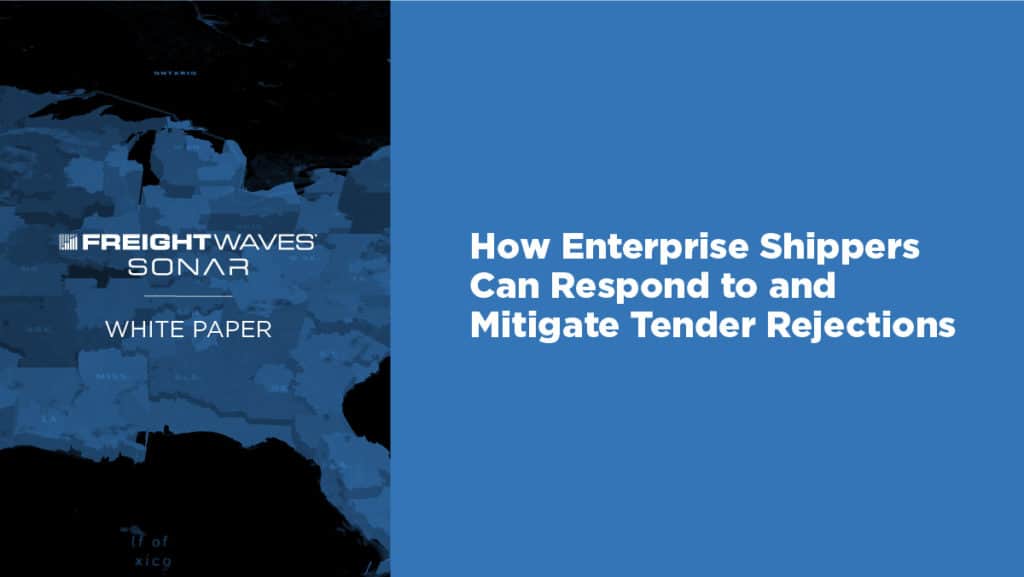Finding ways to lower transportation costs has never been more important than in the age of ever-lasting disruption. As truckload capacity tightens, more companies find themselves faced with a choice between paying the cost of higher shipping or passing it along to customers, affecting all facets of freight management along the way. For instance, as carrier rejection rates increase in outbound tenders, shown above, rates will climb, and predictions within the current FWS7.USA ticker show a trend toward significant increases going forward. However, those rates directly relate back to and drive short-term bids on other loads, whether full truckload, less-than-truckload or another shipping option. Yes, the rates may surround contract at the time, but that information is invaluable to all shippers and freight management parties.
Simultaneously, it becomes a choice between paying extra and getting freight to the customer faster or delaying the shipment and hoping the customer doesn’t bounce to Amazon.
Unfortunately, the risk of losing a customer for either issue – a delay or a higher cost – is simply too great to ignore. Fortunately, that’s where and why many organizations are turning to less-than-truckload, also known as LTL, to source more capacity without the big-time commitments required for full truckload rates. And it’s important to know why.
The biggest impact of less-than-truckload freight management comes from the ability to consider a true alternative to full truckload (TL). At the same time, there’s a massive interest in less-than-truckload among existing and new carriers that provide this mode. According to John D. Schulz in Supply Chain 24/7, “Unlike past years, 2021 will likely be one where a fortuitous combination of pricing discipline and high barriers to entry meet an industry determined not to waste what’s likely a once-a-decade pricing conundrum for shippers fueled by growth in e-commerce.” That’s especially true considering the surging parcel demands created by e-commerce.
Today’s customers are ordering more online and looking forward to receiving it at a faster pace. Unfortunately, full truckload means longer transit times, but tapping the value of a smaller load, while still bigger than parcel, could have the net effect of moving freight without the delays and costs associated with full truckload. As such, customers realize a better price point without necessarily incurring a delay by avoiding a higher rejection risk for the long-haul, full moves.

The barriers to entry to the less-than-truckload space among brokers and carriers are also falling away. While companies tried to overcome the obstacles of dimensional pricing and rate forecasting, those same insights are becoming more attainable and easier to visualize.
For instance, using FreightWaves SONAR, carriers and brokers can gauge profitability, recognize how rates are moving and use that information to diversify their client base freight and offer more service that’s not quite up to the full scale of truckload, protecting against truckload capacity issues and more. In other words, they are able to stay more strategic when it comes to consolidating parcels, optimizing routes and knowing when to accept or reject a load. That’s what it all comes down to and can be a major way for shippers to find a way to move freight at a fraction of the cost of full truckload, while also reaping savings compared to parcel-only shipping too.
Take a moment to think about what freight consolidation really means. It’s seeing and applying analytics data from across the network to combine smaller shipments into the next higher class or mode. As the modes expand to truckload, the cost of transportation becomes lower. However, that can be a misnomer when rates are highly volatile.
For instance, TL rates may be lower in one area but much higher in another. The inability to see those rates in real-time and higher acceptance rates in lanes with a lower risk of rejections may indicate overspending. Regardless, the goal must be the same – find the best rates for the freight that needs to move today. And less-than-truckload offers a way to combine freight to take advantage of market dynamics and even initiate short-term mini-bids, avoiding higher rejection rate trouble, to secure capacity without the typical commitments inherent in full truckload contracts.
Shippers can increase carrier diversity and network size by increasing their average volume through freight consolidation, which takes advantage of both truckload and less-than-truckload shipping. In 2021, it will be imperative for shippers to start thinking about less-than-truckload as more than a nice-to-have resource. It will become a necessity as capacity and rates move in response to the market dynamics. And similarly, carriers and brokers could use the same insights to increase profitability and protect against the instability that will return when the rates swing in the opposite direction. Ultimately, it’s time to realize that less-than-truckload is a critical player in the overall logistics landscape. Get started by requesting a FreightWaves SONAR demo by clicking the button below.
